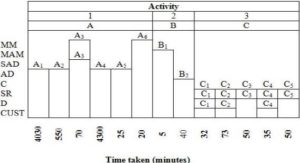Introduction
The significant growth of the internet usage for advertising and selling of products has become dramatic in recent years, particularly with the proliferation of broadband technology. According to ITU (2010), which is a leading agency for information and technology issues, about 64.4% from 26,160,256 of the Malaysian population are using the internet.In fact, the number of internet subscribers expected to reach 10 million in the next five years (Telekom Malaysia, 2007).Considering this volume of data, today many people make use of the internet in working, learning and sales on line with greater speed and accuracy regardless of time and distance.
In 2008, internet sales for the United Kingdom increased by 51% relatively from 2007 to 2008 (Statistical Bulletin, 2009). This number indicates that users preferred to buy and sell online rather than traditional retail shopping. Technically, online business is associated with 4 components, which are product catalogue, Shopping Cart, Transaction Security and processing order. Combination of these elements can provide a true shopping experience to the customer (Greenberg, 2001).
With the influx of businesses conducted online taking advantage of the internet technology, the use of e-catalogue rather than printed version product catalogue has become a viable alternative. The potential to reach a larger market based on online catalogue which is more dynamic, flexible and consumer responsive has been identified by researchers (Vijayasarathy & Jones, 2000). Other researchers such as Kotler (2000) and Muldoon (1996) also predicted that online catalogue will become more popular than traditional print catalogue due to quicker access, price comparison and faster searching capability.
Although the internet offers many potential benefits, direct selling companies still distribute this traditional print catalogue among their dealers nationwide through manual distribution process. Basically, these companies used printed version product catalogue in order to sell their products. With the rapidly high cost distribution and printing, a study by Rosman (2010) identifies approximately RM800,000 monthly was needed to spend on printing and distribution process. This triggered the interest to further examine what is the most suitable application to be applied in order to solve this issue and how Business Process Reengineering technique can improve efficiency and effectiveness of the company performance.
Background of the Study
A direct selling company, which was used in this study, established since 1978 in Malaysia has empowered many women across the Peninsular, including Sabah and Sarawak by providing them with earning opportunities and making their dreams come true. The company’s representatives are supported by their zone manager, training, credit facilities and numerous Beauty Boutiques around Malaysia. The location of the company’s headquarters is based in Petaling Jaya, Selangor.
This company has its own vision which is to be the company that best understands and satisfies the products, services and self-fulfillment needs of women globally. The company has multiple missions in their organization which, among others, are listed as follows:
- To become the world’s most trusted beauty company
- To create lifelong customer relationship
- To achieve economic independency
- To become the largest woman’s foundation
- To create exceptional opportunities for professional growth
- To be a socially responsible, ethical company that is watched and emulated as a model of success
The company developed their own website which is limited to basic information about company profile, account numbers for dealers and short news about current programs. Although the company has their own web site, the company used manual process to distribute their product catalogue to all dealers and Beauty Boutiques around Malaysia.
For the purpose of this study, the process selected for reengineering is the product catalogue distribution process. The complete existing process is presented in a flowchart as illustrated in Fig 1. The description of the existing and reengineering processes for the product catalogue distribution is presented in the next sections.
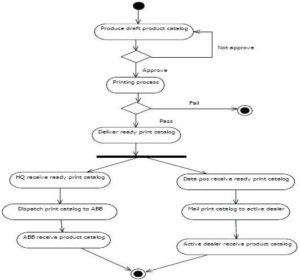
Fig 1. Flowchart of Product Catalogue Distribution Process
Description of Existing Process
The existing business process for the product catalogue distribution process can be summarized as follows:
- The process begins with Art Director to produce a draft of the catalogue.
- The Art Director presents draft to Marketing Manager and Senior Art Director in order to get the approval. If the draft is not approved then it will get back to Art Director for amendment, if the draft is approved and finalized, the work design details and proceeds to printing process.
- The Marketing Manager will check whether the printing process is successful. If the printing is not successful then the process will end. If the printing process is successful then the ready print catalogue will be delivered to HQ and Data Pos.
- From HQ, the bundle of print product catalogue will be dispatched to Beauty Boutiques nationwide.
- From Data Pos, the print product catalogue will be mailed to all active dealers.
Beauty Boutiques and active dealers receive the product catalogue and the process ends.
Based on the analysis of the existing business process, there are seven main activities involved. These are:
- Produce draft product catalogue
- Request for printing product catalogue
- Update record for top sellers and active/ inactive dealers
- Deliver ready print product catalogue
- Data Pos receive ready print product catalogue
- Active dealer receive Product catalogue
- Beauty Boutiques receive Product catalogue
From the main activities, there are sub-activities that should be completed which take time to complete for every stage (See APPENDIX B). People (actors) involved in the work process are as follows:

The total time taken for the whole work processes to complete was 46,186 minutes. This can be shown in the following calculation to identify the value for process efficiency rate and waiting rate:
Calculation of Existing Process
Process Efficiency Rate =Total VAT/TOTAL * 100
= 9193 / 46186 * 100
= 19.90%
= 20% (approximately)
Waiting Rate = Total WT/TOTAL * 100
= 25550 / 46186 * 100
= 55.3%
= 55% (approximately)
Based on the calculation of the existing process, the percentage of Process Efficiency Rate is 20%, whereas the Waiting Rate is 55%. Clearly, the existing process is inefficient and wastes a lot of time as more than half of the time for the process to complete is to wait for the subsequent activity in the process. The BPR technique was used to identify the time consuming activities and introduce ICT to automate the business process.
A Pareto chart (see APPENDIX C) was used to determine and compare significant time-consuming activities that are potential for re-engineering. Basically, this is a bar graph that shows all the activities involved and sorted in descending time order. The longest time taken for each activity will be arranged at the left most position, whereas those activities with the shortest time will be shifted to the right-most position. According to Pareto principle, a 20/80 percent rule was applied to identify the 20% significant activities that contribute to 80% of the time to accomplish the selected business process. The 20% activities generated by the Pareto chart identified the following activities: Keep the print catalogue; Receive the bundle of new print catalogue; Coordinate the printing job; and Distribute print product catalogue that consumed most of the time.
Description of Re-Engineering Process
The idea in this re-engineering process is to make use of the company website to allow every dealer, whether active or not, to view the e-catalogue online. The steps of the process are shown in APPENDICES D and E.
This can be done by introducing a new re-engineer process using the e-catalogue as an online application. With this application, the activities in the work process can be reduced and at the same time it will help to increase the process efficiency rate of the work process.
After the e-catalogue is received from the Marketing Assistance Manager, the Copywriter will upload the e-catalogue to the company web site. Then, dealers, Beauty Boutiques and customers can access the company web site and click on ‘E-catalogue’.
Based on the analysis of the online of the work process schedule, there are three main activities involved. These are:
- Produce draft product catalogue
- Receive e-catalogue
- View e-catalogue
From the main activities, there are sub-activities that should be completed which take time to complete for every stage. The people involved in the work process are: the Marketing Manager, the Marketing Assistant Manager, Senior Art Director, Art Director, Copywriter, Sales Representatives, Dealers, and Customer.
For the re-engineered process, the total time taken for the whole work processes to complete was 9,281 minutes. This can be shown in the following calculation to identify the value of process efficiency rate and waiting rate for the new work process:
Calculation of Re-Engineering Process
Process Efficiency Rate =Total VAT/TOTAL * 100
= 7946 / 9281 * 100
= 85.62%
= 86% (approximately)
Waiting Rate = Total WT/TOTAL * 100
= 667 / 9281 * 100
= 7.19% = 7% (approximately)
The results show that product catalogue distribution process through online application helps to increase the efficiency rate from 20% to 86%. It also shows that the number of waiting time was reduced from 55% to 7%. Therefore, it can be concluded that the proposed e-catalogue incorporating in Business Process Re-engineering technique in this study can contribute to increase process efficiency and provide significant time saving.
Discussion
According to the original work process mapping, 32 activities were needed to accomplish all seven main activities as discussed earlier. From the current analysis (APPENDIX A), the total time to complete the whole process is 46,186 minutes. With the BPR technique, the 32 activities can now be reduced to merely 13 activities, a reduction of almost 60% less activities. The use of e-catalogue allows all dealers to view the catalogue information and latest updates on products within an instance. For the organization, the cost for delivery and printing process can be eliminated. The total time taken to complete the process is reduced to 9,281 minutes compared to 46,186 minutes previously. This indicates that the process after BPR is more efficient compared to existing process where the efficiency rate is up to 86%. Another impact is the waiting time can now be dramatically reduced from 55% to 7%.
Conclusion
In conclusion, adopting the BPR approach could be considered practical, reliable and useful to increase business including manager, employees, dealers and customers, in helping organizations to increase their business performance. The significant result of the business process efficiency shows that the product catalogue distribution process can be simplified by implementing e-catalogue using the BPR approach. There are no more delays, everyone can receive e-catalogue at the appropriate time and also organizations can ultimately reduce the cost for delivery and printing. Finally, in return, all users involved in this process will be able to achieve satisfaction.
(adsbygoogle = window.adsbygoogle || []).push({});
References
Greenberg, P. A. (2001). ‘In E-Commerce We Trust … Not,’ [Online],[Retrieved October 15, 2010], http://WWW.ecommercetimes.com/perl/story/?id=7194
Google Scholar
Hammer, M. & Champy, J. (1993). “Reengineering the Corporation, a Manifesto for Business Revolution,” New York: Harper Collins.
Publisher – Google Scholar
ITU (2010). “Malaysia Internet Usage Stats and Marketing Report,” [Online],[Retrieved October 25, 2010], http://www.internetworldstats.com/asia/my.htm
Publisher
Kotler, P. (2000). ‘Marketing Management,’ Prentice-Hall: Englewood Cliffs, New Jersey.
MAMPU. (2009). ‘Manual Perekayasaan Proses Dan Prosedur Kerja Bagi Sector Awam,’ Putrajaya: Malaysia Government Printing Office.
Muldoon, K. (1995). How to Profit Through Catalogue Marketing (NTC Business Books) Lincolnwood, IL.
Publisher – Google Scholar
Statistical Bulletin. (2009). “E-commerce and Information and Communication Technology (ICT) activity,” 2008, [Online], [Retrieved October 25, 2010], http://www.internetworldstats.com/asia/my.htm
Publisher
Telekom Malaysia (2007). “Malaysia Internet Subscribers to Double by 2012,”[Online],[Retrieved October 25, 2010], http://www.internetworldstats.com/asia/my.htm
Publisher
Vijayasarathy, L. R. & Jones, J. M. (2000). “Print and Internet Catalogue Shopping: Assessing Attitudes and Intentions,” Internet Research, 10(3), 191-202.
Publisher – Google Scholar – British Library Direct
Appendix A: Work Process Schedule for Existing Product Catalogue Distribution Process
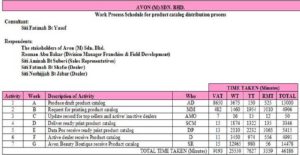
Appendix B: Work Process Mapping for Existing Product Catalogue Distribution Process
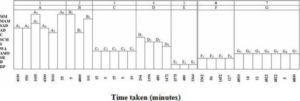
Appendix C: Pareto Chart 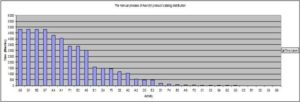
Appendix D: Work Process Schedule for the Re-Engineered Product Catalogue Distribution Process
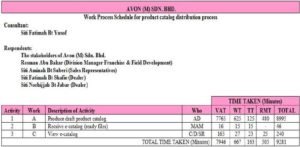
Appendix E: Work Process Mapping for Existing Product Catalogue Distribution Process
